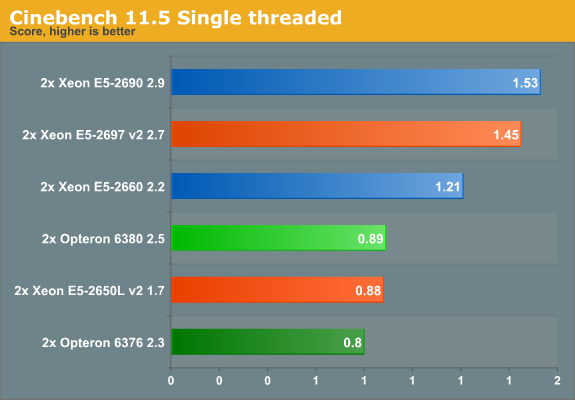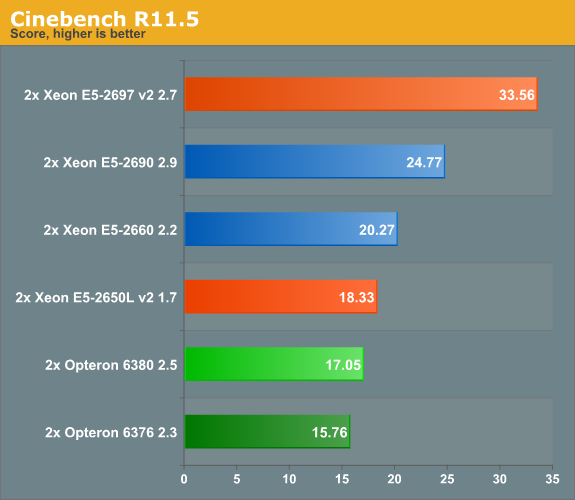Intel's Xeon E5-2600 V2: 12-core Ivy Bridge EP for Servers
by Johan De Gelas on September 17, 2013 12:00 AM ESTRendering Performance: Cinebench
Cinebench, based on MAXON's CINEMA 4D software, is probably one of the most popular benchmarks around as it is pretty easy to perform this benchmark on your own home machine. The benchmark supports up to 64 threads, more than enough for our 24- and 32-thread test servers. First we test single-threaded performance, to evaluate the performance of each core.

Cinebench achieves an IPC between 1.4 and 1.8 and is mostly dominated by SSE2 code. There is little improvement in that area, and the older 2.9-3.8GHz E5-2690 has the clock speed advantage over the new 2.7-3.5GHz E5-2697 v2. Also of note is that i n this type of code, one Piledriver core again needs 50% higher clock speed to keep up with the Ivy Bridge core.

Once we run up to 48 threads, the new Xeon can outperform its predecessor by a wide margin of ~35%. It is interesting to compare this with the Core i7-4960x results , which is the same die as the "budget" Xeon E5s (15MB L3 cache dies). The six-core chip at 3.6GHz scores 12.08. It is clear that chosing cores over clock speed is a good strategy in rendering farms: the dual E5-2650L offers 50% better performance in a power budget that is more or less the same (2x70W vs 130W).










70 Comments
View All Comments
JohanAnandtech - Friday, September 20, 2013 - link
I have to admit were are new to SPECjbb 2013. Any suggestions for the JVM tunings to reduce the GC latency?mking21 - Wednesday, September 18, 2013 - link
Surely its more interesting to see if the 12 core is faster than the 10 and 8 core V2s.Its not obvious to me that the 12 Core can out perform the 2687w v2 in real world measures rather than in synthetic benchmarks. The higher sustained turbo clock is really going to be hard to beat.
JohanAnandtech - Wednesday, September 18, 2013 - link
There will be a follow-up, with more energy measurements, and this looks like a very interesting angle too. However, do know that the maximum Turbo does not happen a lot. In case of the 2697v2, we mostly saw 3 GHz, hardly anything more.mking21 - Wednesday, September 18, 2013 - link
Yes based on bin specs 3Ghz is what I would expect from 2697v2 if more than 6 or more cores are in use. 5 or more cores on 2687wv2 will run @ 3.6Ghz. While 2690v2 will run 3.3Ghz with 4 or more cores. So flat out the 12 core will be faster than 10 core will be faster than 8 core - but in reality hard to run these flat out with real-world tasks, so usually faster clock wins. Look forward to u sharing some comparative benchmarks.psyq321 - Thursday, September 19, 2013 - link
3 GHz is the maximum all-core turbo for 2697 v2.You are probably seeing 3 GHz because several cores are in use and 100% utilized.
JohanAnandtech - Friday, September 20, 2013 - link
With one thread, the CPU ran at 3.4 GHz but only for very brief periods (almost unnoticeable).polyzp - Saturday, September 21, 2013 - link
AMD's Kaveri IGPU absolutley destroys intel iris 5200! Look at the first benchmarks ever leaked! +500% :OAMDFX .blogspot.com
Jajo - Tuesday, October 1, 2013 - link
E5-2697v2 vs. E5-2690 +30% performance @ +50% cores? I am a bit disappointed. Don't get me wrong, I am aware of the 200 Mhz difference and the overall performance per watt ratio is great but I noticed something similar with the last generation (X5690 vs. E5-2690).There are still some single threaded applications out there and yes, there is a turbo. But it won't be aggressive on an averagely loaded ESXi server which might host VMs with single threaded applications.
I somehow do not like this development, my guess is that the Hex- or Octacore CPUs with higher clocks are still a better choice for virtualization in such a scenario.
Just my 2 cents
Chrisrodinis - Wednesday, October 23, 2013 - link
Here is an easy to understand, hands on video explaining how to upgrade your server by installing an Intel E5 2600 V2 processor: http://www.youtube.com/watch?v=duzrULLtonMDileepB - Thursday, October 31, 2013 - link
I think 12 core diagram and description are incorrect! The mainstream die is indeed a 10 core die with 25 MB L3 that most skus are derived from. But the second die is actually a 15 core die with 37.5 MB. I am guessing (I know I am right :-))That they put half of the 10 core section with its QPIs and memory controllers, 5 cores and 12.5 MB L3 on top and connected the 2 sections using an internal QPI. From the outside it looks like a 15 core part, currently sold as a 12 core part only. A full 15 core sku would require too much power well above the 130W TDP that current platforms are designed for. They might sell the 15 core part to high end HPC customers like Cray! The 12 core sku should have roughly 50% higher die area than the 10 core die!